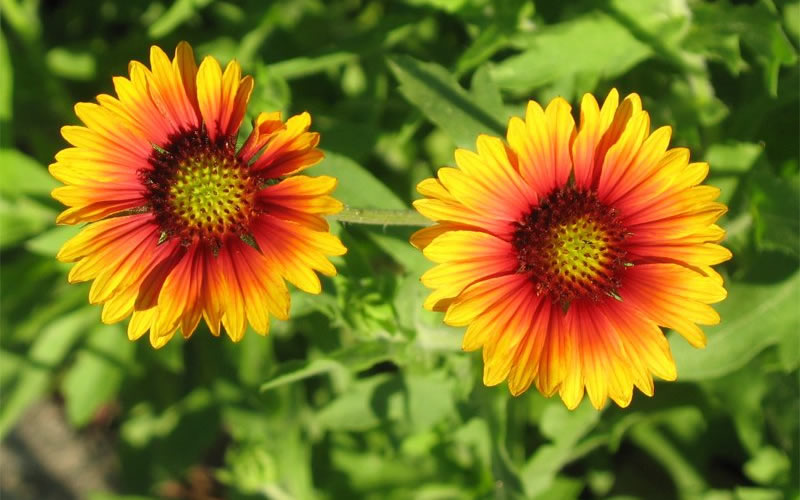Blanket flowers (genus Gaillardia), a member of the sunflower family, are North and South American natives. Other names for the plant include Indian blanket, firewheel, sundance, and perfume ball. The names “blanket flower” and “Indian blanket” refer to the plant’s ability to colonize, spreading and blanketing the soil.

Appearance
Flowers similar to the daisy in form adorn the plant over a long blooming period. Each bloom contains a colorful ray floret and a disc floret, causing the flower to appear “fringed.” Bloom colors include deep red, deep purple, orange, yellow, and white. The plant enjoys a long blooming season, spanning both the summer and autumn. The leaves are hairy and grey green in color, typically alternating along the stem or bunched at the base of the plant. Blanket flower colonizes and spreads.
Environment
The blanket flower grows all across the Americas. As such, most blanket flowers are hardy, or at least frost hardy – accepting cold weather but unable to endure a direct frost. Blanket flower can be grown annually in all USDA plant hardiness zones. Perennial varieties do best in Zones 4 through 9. The plant is naturalized even in areas that it does not naturally occur. For example, G. pulchella is native to western prairies and sandy areas of the southern United States, but it can be found in other regions where it has escaped from cultivation.
Varieties
In addition to the wild, native varieties, a number of cultivars have been developed for ornamental use in the garden. These typically have larger, showier flowers, and include:
“Kobold” has red and yellow outer florets and a dark red inner floret. The plant is considered a perennial, but is generally short lived.
Gaillardia × grandiflora “Oranges and Lemons” is a hybrid of G. aristata and G. pulchella. It sports large, yellow blooms with reddish orange petal bases, and a ringed yellow and red center.
“Arizona Red Shades” produces blooms that are nearly solid red, some with yellow centers.
Dwarf Gaillardia are smaller and more compact plants, growing only 8 to 12 inches in height. They come in shades of yellow, orange, red, and bi-color.
Fanfare Gaillardia are unique in that the ray petals are fluted, or trumpet shaped. This variety may have red blooms or yellow and pink bi-color petals.
Care
Blanket flower does best in full sun. It may be purchased as a mature plant or sown from seed. If using seed, plant after the last frost in spring, or start indoors three weeks prior to the last frost. In warm climates, blanket flower can also be sown in early autumn. Deadhead regularly to prolong blooming.
Frost hardy varieties may be able to overwinter with a little additional protection. Mulch heavily around the plant to protect the roots, and cover with cloth or clear plastic when there is danger of frost. Perennials can be propagated by division in early spring or late autumn. Annuals are best sown from seed.
Benefits
Blanket flower does well in sandy soils, and prefers a dry environment. This makes it an ideal addition to the drought garden. Its spreading nature suits it to naturalization and the prevention of soil erosion.
As a native species, blanket flower does not risk becoming an invasive pest, as do some other garden species. They can also provide a welcome food source for native pollinators. Some butterfly and moth caterpillars feed exclusively on specific Gaillardia species.
Blanket Flower Quick Facts
Height: Up to one meter
Lifespan: Annual, biennial, or perennial
Flowers: Daisy-like, with ray and disc florets, in shades of red, orange, yellow, and white
Seeds: Pyramid shaped pods with a hairy base
Leaves: Hairy and grey green, grouped or alternating
Regions: Annual in Zone 1 to 10, perennial in Zone 4 to 9
Genus: Gaillardia
Species: G. pulchella, G. aristata, and others
Resources
Cathcart, Tavia, and Dennis Horn. Wildflowers of Tennessee, the Ohio Valley, and the Southern Appalachians. 2005.
“Gaillardia.” Wikipedia.
“Gaillardia, Plant Genus.” Encyclopaedia Brittanica.
Hattatt, Lance. Encyclopedia of Garden Plants and Flowers. 1998.
“How to Grow Gaillardia Plants.” Gardeners HQ.
